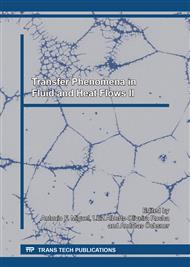[1]
A. BejanShape and structure, from engineering to nature. Cambridge: Cambridge Univ. Press, (2000).
Google Scholar
[2]
A. BejanDesign in nature: how the constructal law governs evolution in biology, physics, technology, and social organization, 1st ed. New York: Doubleday, (2012).
Google Scholar
[3]
A. BejanConstructal Law: Optimization as Design Evolution, J. Heat Transf. 137 (6) (2015) 61003.
Google Scholar
[4]
A. BejanConstructal-theory network of conducting paths for cooling a heat generating volume, Int. J. Heat Mass Transf. 40 (4) (1997) 799–816.
DOI: 10.1016/0017-9310(96)00175-5
Google Scholar
[5]
S. Lorente, W. Wechsatol, and A. BejanTree-shaped flow structures designed by minimizing path lengths, Int. J. Heat Mass Transf. 45 (16) (2002) 3299–3312.
DOI: 10.1016/s0017-9310(02)00051-0
Google Scholar
[6]
A. Bejan and S. LorenteThe constructal law and the evolution of design in nature, Phys. Life Rev. 8 (3) (2011) 209–240.
Google Scholar
[7]
G. Marck, J. -L. Harion, M. Nemer, S. Russeil, and D. BougeardA new perspective of constructal networks cooling a finite-size volume generating heat, Energy Convers. Manag. 52 (2) (2011) 1033–1046.
DOI: 10.1016/j.enconman.2010.08.032
Google Scholar
[8]
G. Lorenzini, C. Biserni, and L. A. O. RochaGeometric optimization of isothermal cavities according to Bejan's theory, Int. J. Heat Mass Transf. 54 (17–18) (2011) 3868–3873.
DOI: 10.1016/j.ijheatmasstransfer.2011.04.042
Google Scholar
[9]
M. Eslami and K. JafarpurThermal resistance in conductive constructal designs of arbitrary configuration: A new general approach, Energy Convers. Manag. 57 (2012) 117–124.
DOI: 10.1016/j.enconman.2011.12.010
Google Scholar
[10]
G. Lorenzini, C. Biserni, E. da Silva Diaz Estrada, E. Domingues Dos Santos, L. André Isoldi, and L. A. Oliveira RochaGenetic Algorithm Applied to Geometric Optimization of Isothermal Y-Shaped Cavities, J. Electron. Packag. 136 (3) (2014) 31011.
DOI: 10.1115/1.4027421
Google Scholar
[11]
L. Kuddusi and N. EğricanA critical review of constructal theory, Energy Convers. Manag. 49 (5) (2008) 1283–1294.
Google Scholar
[12]
A. H. ReisConstructal Theory: From Engineering to Physics, and How Flow Systems Develop Shape and Structure, Appl. Mech. Rev. 59 (5) (2006) 269.
Google Scholar
[13]
C. Biserni, L. A. O. Rocha, and A. BejanInverted fins: geometric optimization of the intrusion into a conducting wall, Int. J. Heat Mass Transf. 47 (12–13) (2004) 2577–2586.
DOI: 10.1016/j.ijheatmasstransfer.2003.12.018
Google Scholar
[14]
C. Biserni, L. A. O. Rocha, G. Stanescu, and E. LorenziniConstructal H-shaped cavities according to Bejan's theory, Int. J. Heat Mass Transf. 50 (11–12) (2007) 2132–2138.
DOI: 10.1016/j.ijheatmasstransfer.2006.11.006
Google Scholar
[15]
G. Lorenzini, C. Biserni, and L. A. O. RochaConstructal design of X-shaped conductive pathways for cooling a heat-generating body, Int. J. Heat Mass Transf. 58 (1–2) (2013) 513–520.
DOI: 10.1016/j.ijheatmasstransfer.2012.11.040
Google Scholar
[16]
S. Ordonez, J. C. J. A. Souza, Constructal optimization of high conductivity inserts in plates with internal heat generation. In Constructal Law and the Unifying Principle of Design, L. A. O. Rocha, S. Lorente, and A. Bejan, Eds., New York, NY: Springer New York, p.91–111, (2013).
DOI: 10.1007/978-1-4614-5049-8_6
Google Scholar
[17]
Y. A. ÇengelHeat and mass transfer: fundamentals & applications, 4th ed. New York: McGraw-Hill, (2011).
Google Scholar


